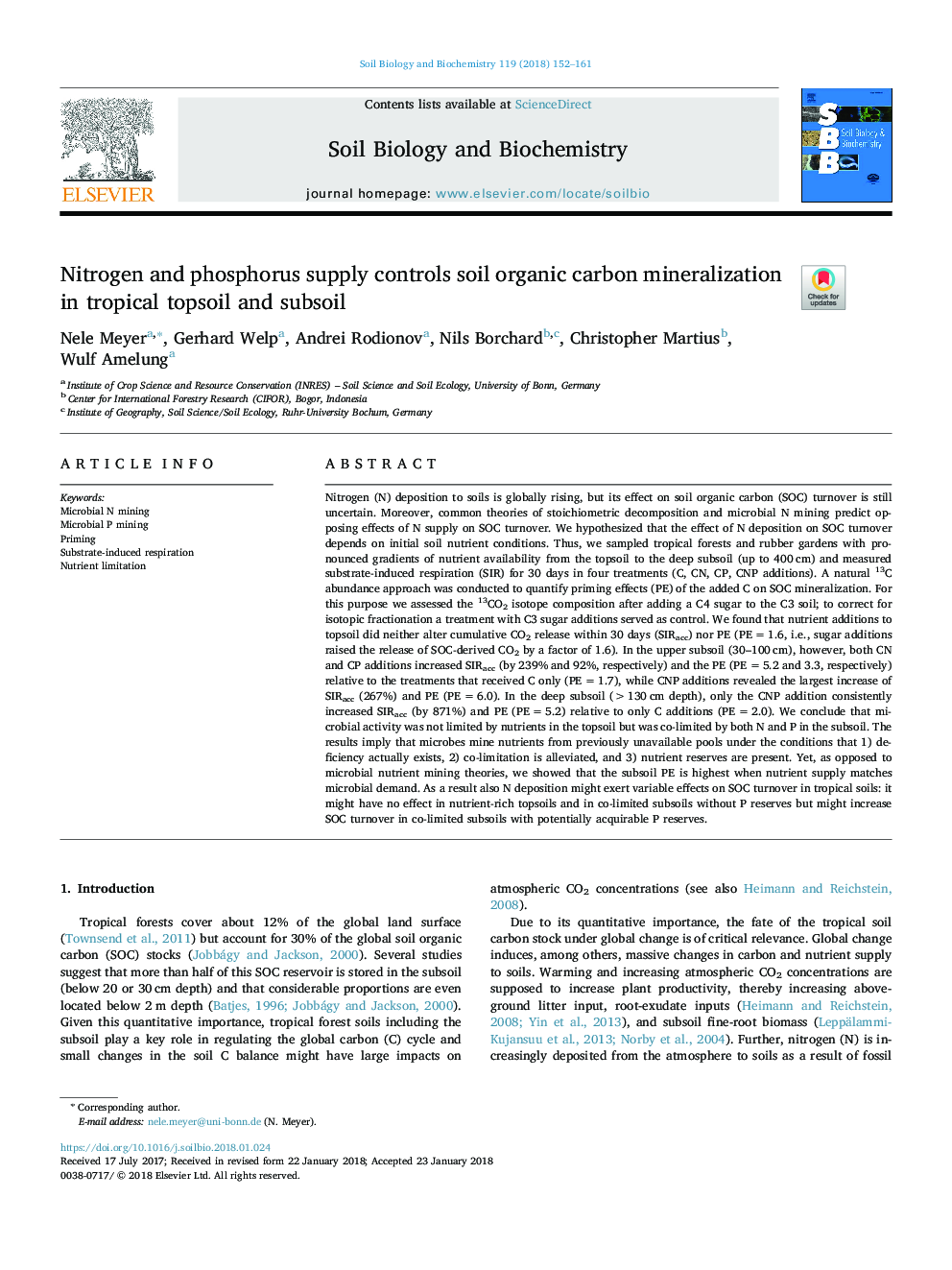| کد مقاله | کد نشریه | سال انتشار | مقاله انگلیسی | نسخه تمام متن |
|---|---|---|---|---|
| 8362922 | 1542565 | 2018 | 10 صفحه PDF | دانلود رایگان |
عنوان انگلیسی مقاله ISI
Nitrogen and phosphorus supply controls soil organic carbon mineralization in tropical topsoil and subsoil
ترجمه فارسی عنوان
کنترل نیتروژن و فسفر کنترل کانی سازی کربن آلی خاک در خاک های خاکی و زیر زمین است
دانلود مقاله + سفارش ترجمه
دانلود مقاله ISI انگلیسی
رایگان برای ایرانیان
کلمات کلیدی
موضوعات مرتبط
علوم زیستی و بیوفناوری
علوم کشاورزی و بیولوژیک
دانش خاک شناسی
چکیده انگلیسی
Nitrogen (N) deposition to soils is globally rising, but its effect on soil organic carbon (SOC) turnover is still uncertain. Moreover, common theories of stoichiometric decomposition and microbial N mining predict opposing effects of N supply on SOC turnover. We hypothesized that the effect of N deposition on SOC turnover depends on initial soil nutrient conditions. Thus, we sampled tropical forests and rubber gardens with pronounced gradients of nutrient availability from the topsoil to the deep subsoil (up to 400â¯cm) and measured substrate-induced respiration (SIR) for 30 days in four treatments (C, CN, CP, CNP additions). A natural 13C abundance approach was conducted to quantify priming effects (PE) of the added C on SOC mineralization. For this purpose we assessed the 13CO2 isotope composition after adding a C4 sugar to the C3 soil; to correct for isotopic fractionation a treatment with C3 sugar additions served as control. We found that nutrient additions to topsoil did neither alter cumulative CO2 release within 30 days (SIRacc) nor PE (PEâ¯=â¯1.6, i.e., sugar additions raised the release of SOC-derived CO2 by a factor of 1.6). In the upper subsoil (30-100â¯cm), however, both CN and CP additions increased SIRacc (by 239% and 92%, respectively) and the PE (PEâ¯=â¯5.2 and 3.3, respectively) relative to the treatments that received C only (PEâ¯=â¯1.7), while CNP additions revealed the largest increase of SIRacc (267%) and PE (PEâ¯=â¯6.0). In the deep subsoil (>130â¯cm depth), only the CNP addition consistently increased SIRacc (by 871%) and PE (PEâ¯=â¯5.2) relative to only C additions (PEâ¯=â¯2.0). We conclude that microbial activity was not limited by nutrients in the topsoil but was co-limited by both N and P in the subsoil. The results imply that microbes mine nutrients from previously unavailable pools under the conditions that 1) deficiency actually exists, 2) co-limitation is alleviated, and 3) nutrient reserves are present. Yet, as opposed to microbial nutrient mining theories, we showed that the subsoil PE is highest when nutrient supply matches microbial demand. As a result also N deposition might exert variable effects on SOC turnover in tropical soils: it might have no effect in nutrient-rich topsoils and in co-limited subsoils without P reserves but might increase SOC turnover in co-limited subsoils with potentially acquirable P reserves.
ناشر
Database: Elsevier - ScienceDirect (ساینس دایرکت)
Journal: Soil Biology and Biochemistry - Volume 119, April 2018, Pages 152-161
Journal: Soil Biology and Biochemistry - Volume 119, April 2018, Pages 152-161
نویسندگان
Nele Meyer, Gerhard Welp, Andrei Rodionov, Nils Borchard, Christopher Martius, Wulf Amelung,
